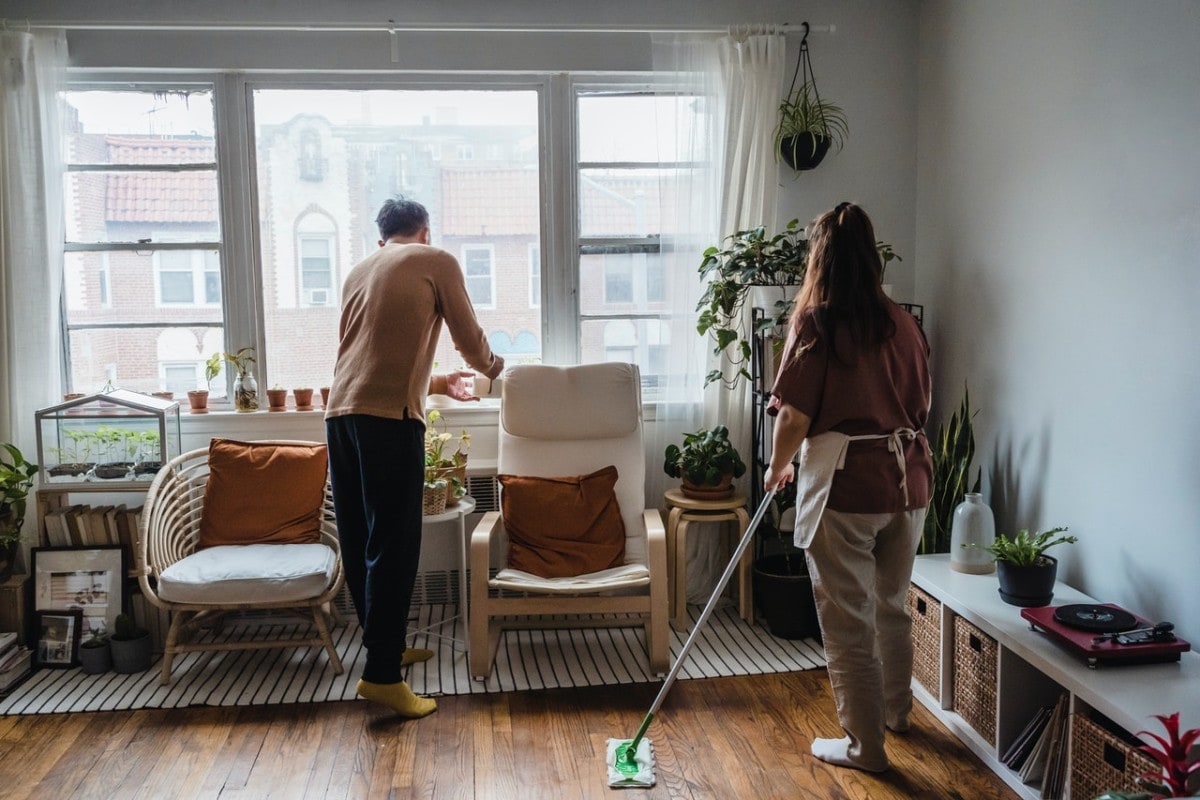Being an adult means learning to compromise, but when it comes to organization, is it possible? We all have different tolerances for messiness, just like we do for cleanliness. And if you find yourself constantly picking your battles with your partner’s “quirks” —like finding socks scattered around the bedroom, pots and pans soaking in the sink for days, or jackets draped over chairs — it can be difficult to get through the day.
But according to the pros, there are several things you can do to work together and find a happy medium when it comes to organization and communication. We reached out to experts for their best tips on sharing a space with a partner with a different organizational style – without losing your mind. Whether you’re renting an apartment in Chicago where space isn’t a luxury or moving in together to your new rental in Austin, here are tips to navigate the organizational mismatch without it resulting in the blame game.

Focus on each other’s strengths
Instead of wanting your partner to be different, celebrate them for the unique strengths they bring and find ways for both of your unique strengths to shine. Chances are, you have slightly different ways of keeping things organized and managing things. When we first fall in love with someone, it’s very easy to see their strengths. However, the longer we are with someone, it’s easy to begin focusing on the flipside. For example, we treasure that our partner is relaxed but then judge them for not being tidier. Or we praise them for being so organized and then lament that they are so particular. –Center for Thriving Relationships
Come to a meeting of the minds
Research shows that happy couples are light-hearted and joke about intractable differences rather than constantly trying to solve them, so start your negotiations in this frame of mind. Differences in how tidy or messy you are or how you see the purpose of your living areas can become troublesome conflicts within a couple over time. Often these issues can represent deep-seated practices and values that represent our identity or upbringing. Successful couples listen and understand each other’s dreams and goals: talk about and listen to each other about where your ways of organizing space come from, what it represents for each of you and how it makes you feel. It’s an opportunity to learn something about each other’s inner world through their way of organizing space. –Relationship Coaching with Rachel New
Avoid playing the “blame game”
Be curious instead of trying to prove your partner wrong. It’s when we start judging each other that we get into trouble. Instead, try asking, “What’s important to you about organizing in this way?” –Vanguard Relationship Coaching
Stop thinking of everything in terms of “their stuff” and “my stuff,” and start thinking about “our stuff.” Go through everything, choose the best item(s) from each category, then donate all duplicate items to a local nonprofit. –Magic by Michelle LLC
Communicate openly and fairly
Communication is key. Your partner may not be aware that you dislike cups off the coaster or the shower curtain open; they simply may be oblivious to it. Kindly communicate to your significant other how a little goes a long way when staying tidy. Most importantly, express how it makes you feel. If your partner knows that it’s seemingly frustrating to you when the place is out of order, and it can seep into the relationship, then we can understand the importance of it. Plus, a tidy environment equals a less distracted mind. –Talk With Aleksandra
Be intentional and talk with your partner about what you need to feel comfortable in the space. You might need the floor swept every evening. Your partner may want to have lights on a dimmer switch. And you both may need a quiet space in the home to be alone with your thoughts. It’s best to talk about these things before you move in so you can let go of the need to control everything in the house and creatively work out solutions. –Elizabeth Golembiewski, The True Love Coach

Create an easy-to-follow routine for shared spaces
Work together to create systems that work for both of you in shared spaces and make sure you are on the same page about where things go. The key to organization is to categorize items and have a “home” for everything. Labeling any bins, shelves, or baskets will help you get in the habit of placing things in their designated spots. A great way to keep everything under control day to day is to put 10 minutes aside each night where you and your partner do a reset to put everything back in its “home.” –Organize With Brianna
For shared mutual spaces, follow the rule: don’t put it down; put it away. When it comes to places like the living room, kitchen, or bathroom, establish a home for all the items that live there (for example, the remote always goes in the top drawer of the coffee table, or the toothbrushes live in the medicine cabinet). When you or your spouse is done using an item, don’t put it down; put it away–back to its predetermined home. It’s important to lead by example and know that the only person you can change is yourself. You’ll drive yourself crazy thinking you can change the other person into being just like you. Focus on keeping your spaces, drawers, and half of the closet and lose the expectation that the other person will do the same – you may rub off on them. –Get It Dunn
Shared spaces require the same TLC as any relationship and should represent the best version of you as a couple. Daily nurturing, frequent check-ins, respecting boundaries, and letting go of any form of clutter can support a healthy balance within your space for years to come. By filling any open space with less stuff and more you, you’ll have the room to grow strong and sustainable roots. –Chesterfield Organizing Co.
Get rid of excess
While unpacking and moving in, assess your personal belongings for purpose and function. If you own anything you don’t need or use, it can create clutter, creating frustration in the relationship. Also, remove all items from past relationships if possible. This will allow the current relationship to flourish fully. –Home Love Method
Moving in with your significant other usually means double or triple “like items.” Go through the home that will be shared and do a major declutter of shared spaces like the kitchen, living room, dining room, bathroom, closet, and bedroom. Then, do an inventory check of major appliances, furniture, and essential living items like dish sets, silverware, glasses, sheets, and towels. Discussing what each of you has and downsizing and decluttering ahead of the big move-in is much less stressful than moving everything in and then deciding. –Tumbleweed Organizing

Keep it streamlined
Simplify your move as much as possible.
- Plan ahead: Have at least a high-level moving strategy in a handy “moving file” that lays out your moving timeline, schedules, and budget, as well as a moving checklist to ensure you don’t forget anything.
- Get rid of dead weight: Declutter and get rid of items in your old home before packing to save time and money. If it doesn’t have a specific place and purpose, it doesn’t go to your new home.
- Organize items before packing: Once you decide what you are taking, pack like or related items together for each room to make unpacking less painful. –Judy On The Spot
Start with a clean slate by decluttering
Declutter until you can declutter no more before the big move. Turn up the music with a playlist of your favorite energy-packed songs as you declutter and ditch anything you no longer use or love. Think “quality over quantity,” so take only the best of the best items with you in your new space and journey. –Organize with Grace
Inventory, communicate, and purge. We often underestimate what we have, how much we have, and how much space we have to store it. Each individual should make a detailed inventory of what they have. Communicate and compare lists. Do you really need 25 towels, ten sets of sheets for one bed and two complete and three partial sets of dishes? Where you see duplicates, keep the best and purge the rest. And if you each have 150 inches of clothes hanging in your closets and the new closet only has 150 inches of hanging space for the two of you, you need to make some decisions and purge, purge, purge! –Duly Organized
Make organizing as easy as possible
When you move in with a significant other, organizing a new kitchen and planning meals together can be an adjustment. Investing in organizational tools like pantry and fridge/freezer bins, cabinet organizers, and stackable shelves can make the process easier. A kitchen where it’s easier to find things helps to take the stress out of cooking and makes it more likely that you’ll feel like getting in the kitchen. Create a list of “self-care meals” that consist of items they always have available in their freezer or pantry for when the motivation to cook is low. –Danica Jacobs, MAN, RD
Baskets and bins are essential; don’t forget to label them too. If you or your significant other can just toss something in a basket, it’s more likely to stay organized. It also helps to separate what you can. For example, in the bathroom, you should each have your own bin with your toiletries to keep it accessible and easy to put away. –Bracket and Bin Organizing

 United States
United States Canada
Canada